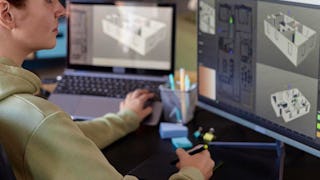This hands-on course equips learners with the essential skills to apply, implement, and integrate core gameplay mechanics in Unreal Engine by building a functional First-Person Shooter (FPS) prototype. Through a structured, project-based approach spanning seven detailed modules, learners will progressively construct interactive components ranging from player control and input systems to AI behavior and scoring mechanics.

Gain next-level skills with Coursera Plus for $199 (regularly $399). Save now.

Unreal Engine Game - FPS Prototype
This course is part of Unreal Engine FPS & Action Game Development Specialization

Instructor: EDUCBA
Included with
Skills you'll gain
Details to know

Add to your LinkedIn profile
August 2025
21 assignments
See how employees at top companies are mastering in-demand skills

Build your subject-matter expertise
- Learn new concepts from industry experts
- Gain a foundational understanding of a subject or tool
- Develop job-relevant skills with hands-on projects
- Earn a shareable career certificate

There are 7 modules in this course
This module introduces learners to the foundational setup required to build a first-person shooter (FPS) prototype in Unreal Engine. It emphasizes working from a blank project using built-in assets, guiding learners through project creation, character and AI initialization, and command input configuration. The module encourages hands-on understanding of Unreal Engine’s game architecture, player-pawn relationships, and the distinction between input mapping types using both Blueprints and code insights. By the end of this module, learners will have a fully structured FPS base ready for interaction and further development.
What's included
6 videos3 assignments
This module introduces the essential mechanics for handling user inputs and targeting in a first-person shooter game. Learners will explore mouse-driven events, input modules, and the visual feedback systems necessary for accurate gameplay interaction. Through practical work in Unreal Engine, they will create crosshair UI components, bind game functions to user-defined actions, and build reusable Blueprint logic for firing controls. This module empowers learners to take full control of player inputs and integrate visual aiming mechanisms that are fundamental to responsive FPS gameplay.
What's included
6 videos3 assignments
This module guides learners through the creation of a custom playable character and the foundational systems for interactive target practice. Beginning with the setup of a player character and the integration of line-trace-based hit detection, the module progresses into designing simple target objects with reactive movement and hit detection. Learners will gain hands-on experience configuring actors, building Blueprint logic, and preparing in-game testing environments with real-time feedback mechanics.
What's included
6 videos3 assignments
This module explores the enhancement of interactive targets in an FPS prototype by introducing dynamic behaviors and scoring systems. Learners will animate targets through rotation, movement, and shape transformation using Blueprint tools such as timelines and logic branches. The module then transitions into implementing real-time scoring logic, updating the user interface, and ensuring accurate response to hit events. By the end, learners will have fully functioning, responsive targets that contribute to engaging gameplay and visual feedback.
What's included
6 videos3 assignments
This module introduces the functional connections between interactive targets and scoring systems in an FPS prototype. Learners will explore how to validate scoring triggers, structure logic for target hit detection, and update player scores in real time. The module also covers gameplay variable management, including damage values and target movement speed, enabling scalable and tunable gameplay mechanics. Through this hands-on implementation, learners will build robust scoring systems tied directly to player actions and target interactions.
What's included
6 videos3 assignments
In this module, learners explore advanced gameplay enhancement techniques that enrich both player interaction and game aesthetics. They will implement dynamic scoring adjustments, modify visual elements such as mesh materials and particle systems, and integrate health-based effects to provide feedback on gameplay performance. Additionally, learners will dive into Unreal Engine’s content libraries, configure efficient asset usage, and apply foundational AI logic to extend interactive behavior. These skills culminate in creating a visually responsive and behaviorally reactive FPS game environment.
What's included
12 videos3 assignments
This module focuses on enhancing player interactivity and user experience by integrating advanced movement mechanics and functional UI systems. Learners will implement core character features like ammo tracking, sprinting, and crouching, and connect them to intuitive input mappings. Additionally, they will design and develop responsive game screens using Unreal Engine’s widget blueprints, enabling real-time visual feedback such as score displays and in-game variable tracking. By the end of this module, learners will be equipped to create a seamless link between gameplay actions and player-facing interfaces.
What's included
5 videos3 assignments
Earn a career certificate
Add this credential to your LinkedIn profile, resume, or CV. Share it on social media and in your performance review.
Explore more from Design and Product
 Status: Free Trial
Status: Free Trial Status: Free Trial
Status: Free Trial Status: Free Trial
Status: Free Trial Status: Free Trial
Status: Free Trial
Why people choose Coursera for their career




Frequently asked questions
To access the course materials, assignments and to earn a Certificate, you will need to purchase the Certificate experience when you enroll in a course. You can try a Free Trial instead, or apply for Financial Aid. The course may offer 'Full Course, No Certificate' instead. This option lets you see all course materials, submit required assessments, and get a final grade. This also means that you will not be able to purchase a Certificate experience.
When you enroll in the course, you get access to all of the courses in the Specialization, and you earn a certificate when you complete the work. Your electronic Certificate will be added to your Accomplishments page - from there, you can print your Certificate or add it to your LinkedIn profile.
Yes. In select learning programs, you can apply for financial aid or a scholarship if you can’t afford the enrollment fee. If fin aid or scholarship is available for your learning program selection, you’ll find a link to apply on the description page.
More questions
Financial aid available,





